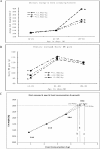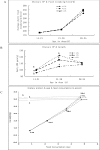Effect of dietary energy and protein content on growth and carcass traits of Pekin ducks
- PMID: 25691755
- PMCID: PMC4990891
- DOI: 10.3382/ps/peu069
Effect of dietary energy and protein content on growth and carcass traits of Pekin ducks
Abstract
A study was conducted to determine the influence of dietary energy and protein concentrations on growth performance and carcass traits of Pekin ducks from 15 to 35 d of age. In experiment 1, 14-d-old ducks were randomly assigned to 3 dietary metabolizable energy (11.8, 12.8, and 13.8 MJ/kg) and 3 crude protein concentrations (15, 17, and 19%) in a 3×3 factorial arrangement (6 replicate pens; 66 ducks/pen). Carcass characteristics were evaluated on d 28, 32, and 35. In Experiment 2, 15-d-old ducks (6 replicate cages; 6 ducks/cage) were randomly allotted to the 9 diets that were remixed with 0.5% chromic oxide. Excreta were collected from d 17 to 19, and ileal digesta was collected on d 19 to determine AMEn and amino acid digestibility. In Experiment 1, there were interactions (P<0.05) between dietary metabolizable energy and crude protein (CP) on body weight (BW) gain and feed intake, wherein BW gain increased more to increasing dietary CP as dietary metabolizable energy increased. However, feed intake was only influenced by dietary crude protein at 11.8 MJ ME/kg and not 12.8 or 13.8 MJ/kg. As dietary CP increased from 15 to 19%, breast meat yield increased by 10.8% on d 35 (P<0.01). Conversely, increasing metabolizable energy from 11.8 to 13.8 MJ/kg increased dressing percentage, breast skin, and subcutaneous fat, but decreased breast meat yield (% but not weight) on d 35 (P<0.01). In Experiment 2, the determined AMEn for diets formulated to contain 11.8, 12.8, or 13.8 MJ ME/kg were 11.66, 12.68, and 13.75 MJ/kg, respectively; determined standardized ileal digestible Lys was 0.95, 1.00, and 1.21% for diets formulated to contain 15, 17, or 19% crude protein, respectively. The best body weight gain and feed conversion ratio was obtained when ducks were fed a high dietary AMEn (13.75 MJ/kg) and high CP (19%, 1.21% SID Lys). These results provide a framework for subsequent modeling of amino acid and energy inputs and the corresponding outputs of growth performance and carcass components.
Keywords: carcass traits; crude protein; duck; metabolizable energy; standardized ileal digestibility.
© The Author 2015. Published by Oxford University Press on behalf of Poultry Science Association.
Figures


Similar articles
-
Effects of dietary protein levels and protease supplementation on growth performance, carcass traits, meat quality, and standardized ileal digestibility of amino acid in Pekin ducks fed a complex diet.Poult Sci. 2020 Jul;99(7):3557-3566. doi: 10.1016/j.psj.2020.03.047. Epub 2020 Apr 27. Poult Sci. 2020. PMID: 32616252 Free PMC article.
-
Effects of dietary energy and lysine levels on growth performance and carcass yields of Pekin ducks from hatch to 21 days of age.Poult Sci. 2017 Sep 1;96(9):3361-3366. doi: 10.3382/ps/pex122. Poult Sci. 2017. PMID: 28605560
-
Effects of dietary energy and protein content and lipid source on growth performance and carcass traits in Pekin ducks.Poult Sci. 2019 Oct 1;98(10):4829-4837. doi: 10.3382/ps/pez217. Poult Sci. 2019. PMID: 30995295
-
The impact of dietary metabolizable energy levels on the performance of medium-sized geese: A systematic review.Poult Sci. 2025 Feb;104(2):104743. doi: 10.1016/j.psj.2024.104743. Epub 2024 Dec 28. Poult Sci. 2025. PMID: 39753051 Free PMC article.
-
Nutritional requirements of meat-type and egg-type ducks: what do we know?J Anim Sci Biotechnol. 2018 Jan 16;9:1. doi: 10.1186/s40104-017-0217-x. eCollection 2018. J Anim Sci Biotechnol. 2018. PMID: 29372052 Free PMC article. Review.
Cited by
-
Balanced nutrient density for broiler chickens using a range of digestible lysine-to-metabolizable energy ratios and nutrient density: Growth performance, nutrient utilisation and apparent metabolizable energy.Anim Nutr. 2021 Jun;7(2):430-439. doi: 10.1016/j.aninu.2020.12.003. Epub 2021 Mar 4. Anim Nutr. 2021. PMID: 34258431 Free PMC article.
-
Study on the Mechanism of MC5R Participating in Energy Metabolism of Goose Liver.Int J Mol Sci. 2023 May 12;24(10):8648. doi: 10.3390/ijms24108648. Int J Mol Sci. 2023. PMID: 37239994 Free PMC article.
-
Effects of dietary lipid sources on growth performance and carcass traits in Pekin ducks.Poult Sci. 2020 Jan;99(1):499-504. doi: 10.3382/ps/pez558. Epub 2019 Dec 30. Poult Sci. 2020. PMID: 32416836 Free PMC article.
-
Effects of Supplemental Feed with Different Levels of Dietary Metabolizable Energy on Growth Performance and Carcass Characteristics of Grazing Naturalized Swan Geese (Anser cygnoides).Animals (Basel). 2021 Mar 5;11(3):711. doi: 10.3390/ani11030711. Animals (Basel). 2021. PMID: 33807953 Free PMC article.
-
Effect of Dietary Protein and Tsaa Levels on Performance, Carcass Traits, Meat Composition and Some Blood Components of Egyptian Geese During the Rearing Period.Animals (Basel). 2020 Mar 25;10(4):549. doi: 10.3390/ani10040549. Animals (Basel). 2020. PMID: 32218190 Free PMC article.
References
-
- Brickett K. E., Dahiya J. P., Classen H. L., Gomis S. Influence of dietary nutrient density, feed form, and lighting on growth and meat yield of broiler chickens. Poult. Sci. 2007;86:2172–2181. - PubMed
-
- Dozier W. A., III, Price C. J., Kidd M. T., Corzo A., Anderson J., Branton S. L. Growth performance, meat yield, and economic responses of broilers fed diets varying in metabolizable energy from thirty to fifty-nine days of age. J. Appl. Poult. Res. 2006;15:367–382.
-
- Fan H., Xie M., Wang W., Hou S., Huang W. Effects of dietary energy on growth performance and carcass quality of white growing Pekin ducks from two to six weeks of age. Poult. Sci. 2008;87:1162–1164. - PubMed
-
- Farhat A., Chavez E. R. Effects of line, dietary protein, sex, age, and feed withdrawal on insulin-like growth factor-I in White Pekin ducks. Poult. Sci. 1999;78:1307–1312. - PubMed
-
- Ghaffari M., Shivazad M., Zaghari M., Taherkhani R. Effects of different levels of metabolizable energy and formulation of diet based on digestible and total amino acid requirements on performance of male broiler. Int. J. Poult. Sci. 2007;6:276–279.
Publication types
MeSH terms
Substances
LinkOut - more resources
Full Text Sources
Other Literature Sources
Medical
Research Materials
Miscellaneous

